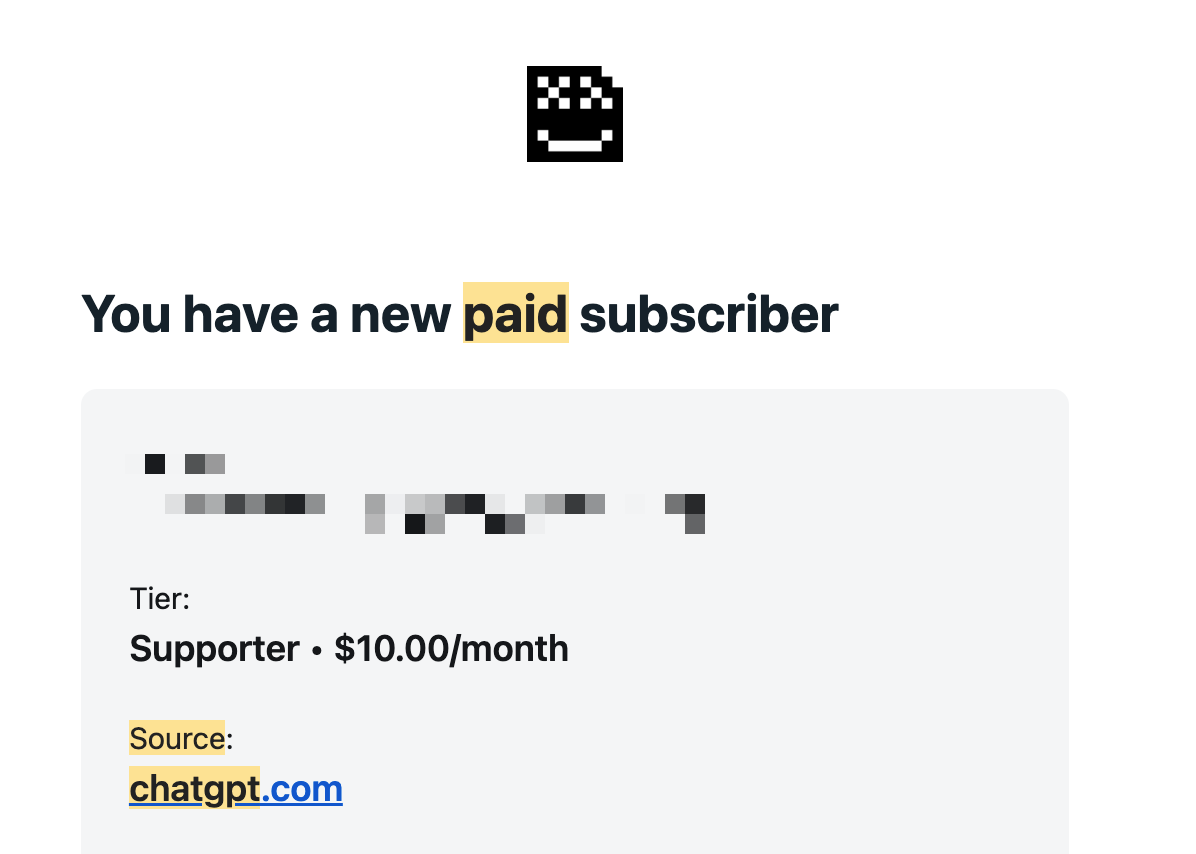Subscribe
On May 23, we got a very interesting email from Ghost, the service we use to make 404 Media. “Paid subscription started,” the email said, which is the subject line of all of the automated emails we get when someone subscribes to 404 Media. The interesting thing about this email was that the new subscriber had been referred to 404 Media directly from chatgpt.com, meaning the person clicked a link to 404 Media from within a ChatGPT window. It is the first and only time that ChatGPT has ever sent us a paid subscriber.
From what I can tell, ChatGPT.com has sent us 1,600 pageviews since we founded 404 Media nearly two years ago. To give you a sense of where this slots in, this is slightly fewer than the Czech news aggregator novinky.cz, the Hungarian news portal Telex.hu, the Polish news aggregator Wykop.pl, and barely more than the Russian news aggregator Dzen.ru, the paywall jumping website removepaywall.com, and a computer graphics job board called 80.lv. In that same time, Google has sent roughly 3 million visitors, or 187,400 percent more than ChatGPT.
This is really neither here nor there because we have tried to set our website up to block ChatGPT from scraping us, though it is clear this is not always working. But even for sites that don’t block ChatGPT, new research from the internet infrastructure company CloudFlare suggests that OpenAI is crawling 1,500 individual webpages for every one visitor that it is sending to a website. Google traffic has begun to dry up as both Google’s own AI snippets and AI-powered SEO spam have obliterated the business models of many media websites.

This general dynamic—plummeting traffic because of AI snippets, ChatGPT, AI slop, Twitter no workie so good no more—has been called the “traffic apocalypse” and has all but killed some smaller websites and has been blamed by executives for hundreds of layoffs at larger ones.
Despite the fact that generative AI has been a destructive force against their businesses, their industry, and the truth more broadly, media executives still see AI as a business opportunity and a shiny object that they can tell investors and their staffs that they are very bullish on. They have to say this, I guess, because everything else they have tried hasn’t worked, and pretending that they are forward thinking or have any clue what they are doing will perhaps allow a specific type of media executive to squeeze out a few more months of salary.
But pivoting to AI is not a business strategy. Telling journalists they must use AI is not a business strategy. Partnering with AI companies is a business move, but becoming reliant on revenue from tech giants who are creating a machine that duplicates the work you’ve already created is not a smart or sustainable business move, and therefore it is not a smart business strategy. It is true that AI is changing the internet and is threatening journalists and media outlets. But the only AI-related business strategy that makes any sense whatsoever is one where media companies and journalists go to great pains to show their audiences that they are human beings, and that the work they are doing is worth supporting because it is human work that is vital to their audiences. This is something GQ’s editorial director Will Welch recently told New York magazine: “The good news for any digital publisher is that the new game we all have to play is also a sustainable one: You have to build a direct relationship with your core readers,” he said.
Becoming an “AI-first” media company has become a buzzword that execs can point at to explain that their businesses can use AI to become more ‘efficient’ and thus have a chance to become more profitable. Often, but not always, this message comes from executives who are laying off large swaths of their human staff.
In May, Business Insider laid off 21 percent of its workforce. In her layoff letter, Business Insider’s CEO Barbara Peng said “there’s a huge opportunity for companies who harness AI first.” She told the remaining employees there that they are “fully embracing AI,” “we are going all-in on AI,” and said “over 70 percent of Business Insider employees are already using Enterprise ChatGPT regularly (our goal is 100%), and we’re building prompt libraries and sharing everyday use cases that help us work faster, smarter, and better.” She added they are “exploring how AI can boost operations across shared services, helping us scale and operate more efficiently.”
Last year, Hearst Newspapers executives, who operate 78 newspapers nationwide, told the company in an all-hands meeting audio obtained by 404 Media that they are “leaning into [AI] as Hearst overall, the entire corporation.” Examples given in the meeting included using AI for slide decks, a “quiz generation tool” for readers, translations, a tool called Dispatch, which is an email summarization tool, and a tool called “Assembly,” which is “basically a public meeting monitor, transcriber, summarizer, all in one. What it does is it goes into publicly posted meeting videos online, transcribes them automatically, [and] automatically alerts journalists through Slack about what’s going on and links to the transcript.”

